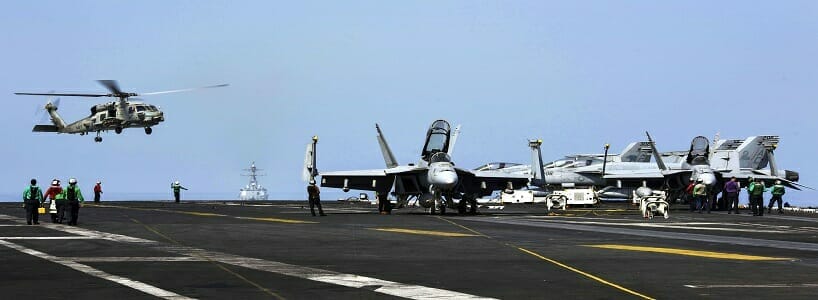Palimpsesto.
Madmaxista
- Desde
- 1 Ago 2021
- Mensajes
- 14.819
- Reputación
- 48.242
No en tiempos de guerra.
First U.S. aircraft carrier of Trump presidency enters the Persian Gulf
American sailors watched as the first Revolutionary Guard vessels appeared on the horizon of the Strait of Hormuz, beginning a daylong face-off that has become familiar to both Iranian paramilitary and U.S. naval forces that pass through the narrow mouth of the Persian Gulf.www.navytimes.com

Pentagon seeks international coalition to guard waterways from Iranian threat - JNS.org
“We’re engaging now with a number of countries to see if we can put together a coalition that would ensure freedom of navigation both in the Straits of Hormuz and the Bab al-Mandab,” said chairman of the Joint Chiefs of Staff Gen. Joseph Dunfordwww.jns.org
En 2017 hasta disparaban

Trump's "Strategic Unpredictability" An Asset Against Iranian Threats
Iran is threatening naval action as U.S. sanctions continue to cripple the troubled nation. But the unpredictable nature of our Commander in Chief should make them think twice. - Intelligencenews.clearancejobs.com
Toggle navigation
Log In
More
Subscribe
ClearanceJobsNews & Career Advice
Trump’s “Strategic Unpredictability” An Asset Against Iranian Threats
Tom McCuin / Aug 28, 2018
INTELLIGENCE
The Islamic Republic of Iran is back in the news again – in a big way. After a brief hiatus from the front pages, the land of the Ayatollahs reminded us all just why its been the subject of such crippling economic sanctions for so long.
When President Donald Trump withdrew the U.S. from the Joint Comprehensive Plan of Action – the deal designed to halt, or at least postpone, Iran’s development of a nuclear weapon – it meant that all the old sanctions were going back into place. The government announced the first round in early August; the remaining sanctions will go into effect on November 5.
In addition to those measures, Trump has mulled the possibility of preventing any Iranian oil exports. This has not sat well in Tehran.
IRAN IS THREATENING NAVAL ACTION
Monday, Gen. Alireza Tangsiri, who commands the naval forces of the Iranian Revolutionary Guards Corps, said his fleet is “prepared to defend the waters with their intelligence dominance and monitoring of the enemy’s physical presence.” Most observers take this as a sign that Iran thinks it is capable of closing the Strait of Hormuz, the narrow passage out of the Persian Gulf into the Indian Ocean.
Shortly before the president announced the reimposed sanctions, Iran began a large-scale naval exercise in the Persian Gulf. Iran controls the north side of the Strait of Hormuz. Oman and the United Arab Emirates control the south side. It is an incredibly important chokepoint; although it is 21 miles wide at its narrowest, the shipping lanes are only two miles wide. As much has a third of the world’s supply of crude oil passes through that narrow passage each day.
Iran’s navy is made up largely of small, fast patrol boats whose speed and maneuverability make them challenging to confront. Further complicating matter is the fact that these small boats carry anti-ship missiles. They have made a habit of harassing U.S. warships in the Gulf for a long time. Incidents typically happened a few times a month – until this year.
The Navy released data in early July that reported there were 22 of these incidents in 2015, 36 in 2016, 14 in 2017, and as of today, zero in 2018. The Iranians claim this is because of a change in U.S. behavior. The Iranians don’t specify what this behavior might be, probably because we’ve taken a more aggressive stance towards them.
NO CARRIER IN THE AREA, BUT DOES THAT MATTER?
It can hardly be a coincidence that Iran makes this announcement at a time when the U.S. Navy’s Fifth Fleet, based out of Bahrain, has no large “capital ships” in the Gulf. None of the Navy’s 11 aircraft carriers or its eight Wasp-class amphibious assault ships are in the Gulf, or even in the region.
The USS Iwo Jima returned to its home port of Mayport, Fla. on August 9 after a deployment that included a stint in the Gulf. The carriers USS Ronald Reagan and USS John C. Stennis are operating in the Pacific, as are the amphibious assault ships USS Wasp and USS Essex. They could be in the Gulf in short order, but they’re still not immediately available. There is airpower available onshore, but carriers make it so much easier to operate.
Veremos a ver si empiezan las palos si dejan el barquito a 200 km de la costa de Irán
